Table of Contents
Did you invest as much time and effort selecting the multivitamin you use every day as you did for the last nootropic you added to your stack?
Like most of us, your answer is likely “No”.
With thousands of multivitamin and mineral complexes to choose from where do you even start?
And then at least once a year we’re slammed with headlines proclaiming multivitamins are harmful to our health.[i] Or simply do not work.[ii]
Who are we to believe?[iii]
In this post we investigate top health concern and the proven benefits of using multivitamins and minerals[iv]. Vitamins that are critical for optimal concentration, memory[v], mood, eliminating brain fog and for overall brain function[vi].
We delve into why we avoid “pharmaceutical grade”, “USP grade” and other synthetic multivitamins and minerals. And how to quickly evaluate “Whole Food” and “Raw Food” vitamins when optimizing brain health.
And which is best? Vitamins and minerals grown in yeast? Or are “chelated” nutrients best for protecting cognitive health.
We then summarize what to look for in a multivitamin supplement, so we are not only getting our money’s worth. We are also choosing the best multivitamin and minerals for optimal brain function while avoiding cognitive decline.
The best multivitamin for men and women on the market today is:
Performance Lab NutriGenesis® Multi
Multivitamins Proven to Benefit Healthy, Young Adults
Research on the effects of multivitamins are most often with the elderly or people dealing with a specific disease. And not with healthy young adults.
So, researchers at Northumbria University set out to determine the effects of multivitamins in healthy people. To find out if a vitamin and mineral supplement could improve mood and mental performance and reduce fatigue.
In a randomized, double-blind placebo-controlled study, 215 healthy men aged 30 – 55 were given a multivitamin or placebo for 33 days.
 The men were tested at the beginning of the study. Then again at the end for mood, stress, memory and general health.
The men were tested at the beginning of the study. Then again at the end for mood, stress, memory and general health.
After 33 days of using a daily multivitamin, researchers reported significant improvements in general mental health, reduced stress, increased vigor, and an overall improvement in mood.
The men who used multivitamins during the trial also showed improved memory and reduced mental fatigue. The placebo group experienced no significant changes.[vii]
While the study itself is encouraging, it fails to report if the “healthy young men” were nutrient deficient in the first place.
Most nutrition experts insist on telling us that a balanced and nutritious diet is the best way to obtain the nutrients we need for optimal health.
But what most of these so-called “experts” who are often quoted in the press fail to recognize is most “healthy” people in our society maintain a less-than-perfect diet.
And study after study show the majority of ‘healthy’ people are nutrient deficient.[viii]
Even the most determined biohackers following a “perfect diet” can still be starved of nutrients.[ix]
Because even if you do eat well, where and how your food was grown directly influences your nutritional intake. Soil quality, storage, processing and cooking all have a significant impact on nutrient levels in your food.
The Problem with our Food Supply
A 2004 study of fruits and vegetables found that everything from protein to calcium, iron and Vitamin C has significantly declined since 1950. The study looked at data for 13 nutrients across 43 vegetable crops.[x]
Research of fruits and vegetables show minerals, vitamins and protein content has dropped substantially over the past 50 – 70 years.
And the problem is not just Big Agra developing new varieties to increase yields at the expense of nutrient density.
The Problem with our Air
Irakli Loladze, a mathematician by training, studied nutrient and vitamin levels in plants for the last 15 years. Loladze found the earth’s atmosphere had 200 parts per million of carbon dioxide (CO2) before the industrial revolution.
Last year, the planet crossed over the 400 parts per million threshold for CO2.
Now this may seem like a good thing because plants thrive on CO2. And higher CO2 levels aid in photosynthesis which means increased plant growth and more food.
But increased and rapid growth also leads to plants creating more carbohydrates like glucose. Instead of other nutrients that our bodies and brains need like protein, iron and zinc.
While at Princeton University in 2002, Loladze published his first paper in Trends in Ecology and Evolution. His paper argued that rising CO2 and human nutrition were inextricably linked through this global shift in plant quality.
This problem with the world’s (and our) food supply has not yet crossed the radars of most health and nutrition experts. Loladze was the first to pull together the math and biology needed to get to the bottom of this potential global catastrophe.[xi]
What does this mean for you when doing whatever you can to improve cognition, memory and mood?
It means you do what you can to eat the best quality and variety of food that you can find. And make up the rest of your body and brain’s demand for nutrition through supplements and nootropics.
One of the best things you can do for your nootropic stack is add a good quality, daily multivitamin.
What to Look for in a Multivitamin
If your multivitamin/mineral supplement doesn’t seem to be providing a benefit you can feel …
… chances are you bought the wrong supplement.
Multivitamins and supplements sold by the big chain discount stores or drug stores are often cheaper, synthetic and usually petroleum-based compounds. And not food-based supplements.
For example, a recent review of 67 studies found “no convincing evidence” that antioxidants reduce the risk of death. And that vitamins A and E interfere with the body’s natural defenses.
Naturally, Big Pharma and mainstream media ensured this study made headlines about how vitamins do not work. And are bad for you.
But no one seemed to notice a quote near the very end of the study that said, “Because we examined only the influence of synthetic antioxidants, our findings should not be translated to potential effects of fruits and vegetables”.[xii]
Best Vitamins for the Brain
As a neurohacker, you are likely onboard with the idea that whole foods are better for you than refined foods. And the same goes for vitamins and minerals.
 Food-based vitamins and minerals are isolated from foods that naturally produce that nutrient. Or created in a yeast-based culture that produces a form identical to what your body recognizes as a vitamin or mineral.
Food-based vitamins and minerals are isolated from foods that naturally produce that nutrient. Or created in a yeast-based culture that produces a form identical to what your body recognizes as a vitamin or mineral.
For example, Vitamin B1 (thiamine) exists in food in the forms of thiamin pyrophosphate, thiamin monophosphate, and thiamin. Non-food Vitamin B1 (thiamin mononitrate) is a coal tar derivative which is never found in the human body.
The table below provides the form of each vitamin found in a food-based multivitamin. And the same type of vitamin to avoid because it is made from a chemical process often using petroleum.
Use the table below to compare to your own bottle of multivitamins. Or a bottle you find on the shelf at the vitamin store.
One of the best ways to tell if a multivitamin bottle contains natural vitamins or non-food vitamins (often called “USP vitamins, or “natural”) is to know the chemical names.
When you see the word “natural” on the bottle, you can be sure it is not the type of vitamins your body will recognize as food.
Food vs Non-Food Vitamins
| Look for this form of vitamin in your multivitamin to buy (food-based) |
Look for this form of vitamin in a multivitamin to avoid (vitamin analogue chemical form – often called “natural” or USP) |
| Vitamin A/Betacarotene; retinyl esters; mixed carotenoids | Vitamin A acetate; betacarotene (isolated) |
| Vitamin B1; thiamin pyrophosphate (food) | Thiamin mononitrate; thiamin hydrochloride; thiamin HCL |
| Vitamin B2; riboflavin, multiple forms (food) | Riboflavin (isolated); USP vitamin B2 |
| Vitamin B3; niacinamide (food) | Niacin (isolated); niacinamide (isolated) |
| Vitamin B5; pantothenate (food) | Pantothenic acid; calcium pantothenate; panthenol |
| Vitamin B6; 5’0 (beta-D) pyridoxine | Pyridoxine hydrochloride; pyridoxine HCL |
| Vitamin B9; folate | Folic acid |
| Vitamin B12; methylcobalamin; deoxyadenosylcobalamin | Cyanocobalamin; hydroxycobalamin |
| Choline (food); phosphatidyl choline (food) | Choline chloride; choline bitartrate |
| Vitamin C; ascorbate (food); dehydroascorbate | Ascorbic acid; most mineral ascorbates (i.e. sodium ascorbate) |
| Vitamin D; mixed forms, primarily D3 (food) | Vitamin D1 (isolated); Vitamin D2 (isolated); Vitamin D3 (isolated); Vitamin D4; ergosterol (isolated); cholecalciferol (isolated); lumisterol |
| Vitamin E; RRR-alpha-tocopherol (food) | Vitamin E acetate; Mixed tocopherols; all-rac-alpha-tocopherol; d-l–alpha-tocopherol; d-alpha-tocopherol (isolated); dl-alpha-tocopheryl acetate; all acetate forms |
| Biotin | All non-yeast or non-rice vegetarian biotin forms |
| Vitamin K; phylloquinone (food) | Vitamin K3; menadione; phytonadione; naphthoquinone; dihydro-vitamin K1[xiii] |
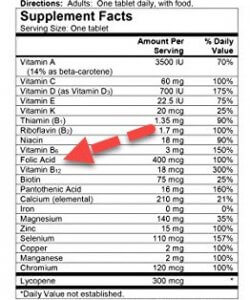 I’ve found one of the simplest and quickest ways to assess a multivitamin or B-Complex bottle for quality and “food-based” is to look for Vitamin B9 (folic acid) or Vitamin B12 (cyanocobalamin); neither of which is food-based.
I’ve found one of the simplest and quickest ways to assess a multivitamin or B-Complex bottle for quality and “food-based” is to look for Vitamin B9 (folic acid) or Vitamin B12 (cyanocobalamin); neither of which is food-based.
If either one is on the label then the entire bottle is to be avoided because the rest of the bottle is unlikely to be a quality, food-based vitamin complex.
The bottom-line is there are only two types of vitamins sold; food vitamins and non-food vitamins.
The label of a food multivitamin will typically read “100% Food”. And should also state “no USP nutrients” or “no synthetic nutrients”.
Avoid USP Vitamins, Pharmaceutical Grade, and Natural or All Natural
Non-food vitamins are a little more difficult to distinguish. They certainly will not state “100% Food” on the label. And they certainly will not claim “no USP or synthetic nutrients”.
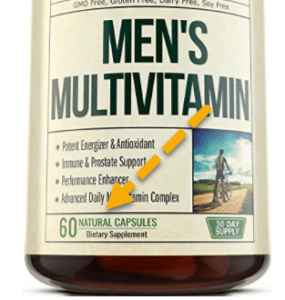 If a multivitamin label states that the product contains “USP vitamins” or “pharmaceutical grade” nutrients you can be sure that it is NOT a food-based vitamin.
If a multivitamin label states that the product contains “USP vitamins” or “pharmaceutical grade” nutrients you can be sure that it is NOT a food-based vitamin.
If a multivitamin bottle declares that it is “natural” or “all natural” you can be pretty sure it is a chemically-derived vitamin complex.
One of the bigger red flags is when a vitamin manufacturer uses the term “yeast-free” on the label. The problem here is most of the highest quality, 100% food-based vitamins are grown in a yeast culture.
Beware of Whole Food Multivitamins
Another sneaky marketing trick vitamin and mineral makers use is to include a blend of fruit and vegetable powders in their multivitamin formula. Leading you to think this “Whole Food” vitamin and mineral stack is all food-based.
If the manufacturer states that their multivitamin is “food-based”, it often indicates synthetic vitamins with a small amount of food powder mixed in to trick you into thinking it’s the real deal.
Whole Food ≠100% Food-Based Vitamin
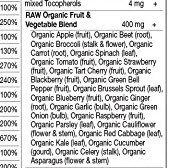 But there’s another problem with these fruit and vegetable powders …
But there’s another problem with these fruit and vegetable powders …
“Whole Food” multivitamins contain anti-nutrients
Natural foods contain oxalates (reducing absorption of calcium, iron and magnesium), phytates (reducing absorption of calcium, chromium, copper, iron, magnesium, manganese, zinc and Vitamin B3 (niacin)) and lectins (which can cause leaky gut and make it difficult to absorb micronutrients).
Doesn’t it seem counter-productive to choose a 100% food-based multi but then have it include fruit and vegetable powders that will prevent their absorption?
Best Minerals for the Brain
Studies have shown that certain minerals are directly involved in cognitive function and assist with avoiding age related cognitive decline.
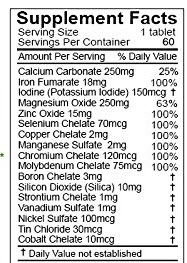 The most critical of these minerals include; calcium, iodine, iron, magnesium, selenium and zinc.
The most critical of these minerals include; calcium, iodine, iron, magnesium, selenium and zinc.
The full list of macrominerals and microminerals looks more like this; boron, calcium, copper, chromium, iodine, iron, manganese, magnesium, molybdenum, phosphorus, potassium, selenium, silicon, strontium, vanadium, and zinc.
In an ideal world, we get minerals from our food. But poor farming practices, depleted soil, loss during storage and transport, loss during cooking, poor digestion and dysfunctional metabolism means …
… most us are deficient.
So, we must supplement with minerals if we want to achieve optimal performance and cognitive health.
But taking minerals as supplements is not as easy as it sounds. Most neurohackers agree that we should avoid consuming industrial chemicals when it comes to vitamins.
But we often overlook these synthetic chemicals when it comes to the minerals our body and brain need to survive and thrive.
Inorganic vs organic minerals
Unlike humans, plants have roots or hyphae which aid in the absorption of minerals. And plants can also decrease the toxicity of compounds by changing their biochemical forms.[xiv]
The first problem is most minerals used in supplements including multivitamin formulas do not contain protein chaperones or other food factors needed for mineral absorption into your cells.
And second, nearly all minerals in supplements are industrial chemicals made from processing rocks with one or more acids. Which is not only un-natural but can lead to toxicity in your body and brain.
Pick up most multivitamin bottles and look at the bottom of the ingredient list for minerals. You will notice right away minerals bound to inorganic minerals like ascorbates, aspartates, glycinates, carbonates, phosphates, picolinic acid, or oxides.
These additional inorganic minerals are bound to other inorganic minerals (processed rocks) in multivitamin formulas in an attempt to boost bioavailability.
But your body was designed to eat food and get your minerals from foods.
Organic minerals naturally found in food are typically attached with some type of peptide. Once digested, the minerals bind to amino acid carriers for transport into and throughout your body.
This binding process is called “chelation”. By binding the two, the amino acid can transport the mineral across the intestinal lining into your bloodstream. And then release the mineral to do its designated job.
Chelated Minerals
We attempt to duplicate this natural process by using mineral supplements. And this is where things break down.
Our bodies are not designed to metabolize minerals like plants do. Binding ground up rocks and attaching the mineral molecule to another inorganic molecule has a questionable safety record.
For example, no one knows for sure the ramifications for the human body by using something like zinc attached to picolinic acid (zinc picolinate) long-term.
Look for a multivitamin that uses chelated organic minerals, or minerals naturally grown in Saccharomyces cerevisiae (brewer’s yeast).
Both methods produce organic minerals that your body can recognize and use.
Yeast-Grown Minerals
Minerals that are cultured in Saccharomyces cerevisiae (brewer’s yeast) use a manufacturing process very similar to conventional farming. The process uses a preparation of the target mineral, seeding it into a yeast culture, allowing the culture to grow and then harvesting.
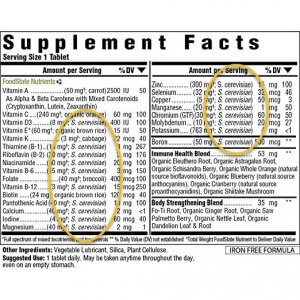 The result is a mineral like what your body expects if it got the same mineral from food.
The result is a mineral like what your body expects if it got the same mineral from food.
You’ll recognize this form of mineral when it is listed on the ingredients label that reads like; “Selenium – from S. cerevisiae”. It means the selenium was cultured in Saccharomyces cerevisiae.
The only supplement company I know of who produces minerals for their supplement line using Saccharomyces cerevisiae (brewer’s yeast) is Performance Lab® with their patented NutriGenesis® growing process.
For example, the Performance Lab® NutriGenesis Multi uses S. cerevisiae to grow all of their minerals contained in that multi.
Mineral chelates on the other hand are more difficult to distinguish. Because any manufacturer can claim their product is a mineral chelate by simply adding an amino acid to a mineral molecule. Which is supposed to improve its bioavailability.
But not all mineral chelates are nutritionally functional or useful to your body.
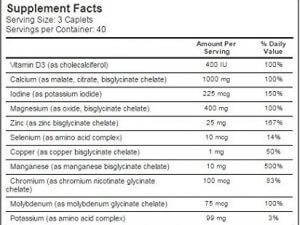 The science behind a nutritionally functional chelate is far too complex for this post. To put it simply, a mineral must be chelated in a specific manner for maximum bioavailability and for metabolism to occur.
The science behind a nutritionally functional chelate is far too complex for this post. To put it simply, a mineral must be chelated in a specific manner for maximum bioavailability and for metabolism to occur.
The only company that I know of who produces mineral chelates that work. And have the science to support their claims is Albion Minerals. The company has more than 70 patents backing up their chelation procedures.
Albion licenses their products to a few of the larger supplement manufacturers like Blue Bonnet, Doctor’s Best, Nature’s Sunshine, Natrol, NOW Foods, Douglas Laboratories, Solgar, and Swanson Vitamins.
What to Avoid in a Multivitamin
The vitamin and dietary supplement market is a $132.8 billion industry.[xv]
This staggering number means an overwhelming number of choices when you’re trying to select the best multivitamin/mineral supplement along with your healthy diet.
We can narrow our focus by choosing to ignore all the vitamins made or processed with petroleum derivatives or hydrogenated sugars.
Some glaring examples of what you do not want in your body. And can be used as a model for your ‘exclusion’ list.
Centrum Multivitamin/Mineral is manufactured by one of the kings of Big Pharma – Pfizer. The Centrum formula contains hydrogenated palm oil, polyethylene glycol, polyvinyl alcohol, and artificial color Yellow #6 which are poison for your mitochondria. The entire formula are synthetic vitamins and minerals made primarily using petroleum derivatives.
Flintstones Complete Multivitamins for kids must safe – right? Think again. Their formula contains glucose syrup, sugar, gelatin, beeswax, carnauba wax, and vegetable oils. Every vitamin and mineral in this stack is synthetic.
One A Day Men’s Health Formula Multivitamin is Amazon’s #1 bestseller for a men’s multi. Which is disheartening. The biggest red flag here, and which you can take away across all major multivitamin brands, uses the dl-alpha-tocopherol acetate form of Vitamin E.
Whenever you see this synthetic version of Vitamin E in a multi formula you can be certain the rest of the formula are cheap, synthetic versions of each vitamin and mineral. Which could result in age related memory decline and cognitive aging instead of keeping your brain healthy.
The quickest way to access the quality of a multivitamin is to scan the ingredients label for the type of Vitamin E, Vitamin B9 (folate) and Vitamin B12 (methylcobalamin).
Folic Acid is the cheap, synthetic version of Vitamin B9 you’ll find in most major brands of vitamins and fortified cereals and other processed foods. You can read more about the problems with Folic Acid in my review of Vitamin B9 here.
Cyanocobalamin is the cheap, synthetic version of Vitamin B12 found in most major multivitamin brands. Your body uses methylcobalamin and not cyanocobalamin.
We have plenty of studies demonstrating the problems using folic acid and cyanocobalamin. One example comes from Johns Hopkins University which found pregnant women with high circulating levels of folic acid and cyanocobalamin tripled their risk of having a child with autism.[xvi]
We have similar problems with synthetic vs natural forms of Vitamin E. Natural Vitamin E is composed of α-tocopherol, ß-tocopherol, γ-tocopherol and δ-tocopherol, and four tocotrienols subunits.
The most common form of synthetic Vitamin E is called DL-alpha-tocopherol acetate (also called all-Ras alpha-tocopherol acetate). If you see either terms for Vitamin E listed on a multivitamin label, put it back on the shelf. It doesn’t work.[xvii]
So keep this in mind …
If you see just one of the synthetic versions of Vitamin E (DL-alpha-tocopherol acetate), Vitamin B9 (folic acid) or Vitamin B12 (cyanocobalamin) …
… you can be certain the entire multivitamin stack is synthetic and useless. Do not buy it!
The bottom-line here is to avoid mass-market synthetics like Centrum, drug store chain brands, grocery store chain brands, most vitamin store chain brands, and membership club brands.
Best Multivitamin for Brain Health
First, be aware that most multivitamins marketed as “natural”, “food-based” or “USP-grade” are synthetic.
The thing is, if a multivitamin formula contains 10% natural, plant-derived ingredients it can legally be advertised as “natural”. The rest of the formula (90%) is synthetic.
A multivitamin can also be marked as 100% organic and not contain a single plant ingredient. It could even be derived from coal tar or wood pulp. But marketed as “organic”.
So, ignore bright, pretty photos of fruits and vegetables and happy models, and concentrate on the ingredients label.
Many ‘natural’ vitamins are synthetics. But not all synthetics are “bad”.
Manufacturers will include something like acetate, bitartrate, chloride, gluconate, hydrochloride, nitrate or succinate to improve bioavailability.
‘Food-sourced’ ingredients generally have some type of food listed after the vitamin name on the label. Identifying the ‘source’ of that nutrient.
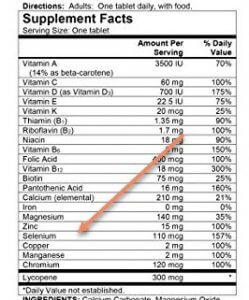 If the vitamin or mineral listed on the ingredients label contains no source (i.e. it’s blank), you can be sure it is synthetic. And is likely a petroleum derivative (or ground up mineral rock).
If the vitamin or mineral listed on the ingredients label contains no source (i.e. it’s blank), you can be sure it is synthetic. And is likely a petroleum derivative (or ground up mineral rock).
The “d” or “dl” form of any vitamin is synthetic. And is almost always bad news. For example, the “DL-alpha-tocopherol acetate” form of Vitamin E has been shown to increase the chances of stroke.[xviii]
Refer to the table above in “Food vs Non-Food Vitamins” of each vitamin for the preferred source.
It should be listed on the label as derived from a food source or made using a yeast culture (i.e. Saccharomyces cerevisiae) for safety and better bioavailability.
Any minerals listed on the label without a source are basically ground up rock.
Minerals that are bound to inorganic minerals like; ascorbates, aspartates, glycinates, carbonates, phosphates, picolinic acid, or oxides are an attempt by the manufacturer to boost bioavailability in your body.
The best source for minerals that your body can use naturally are cultured using yeast (i.e. Saccharomyces cerevisiae) like use in the Performance Lab® NutriGenesis Multi. Or are chelated using the chelation method invented and patented by Albion Minerals. Check the label.
And finally, capsules are better than tablets because they usually do not contain binders, flavoring and coloring. And do not lose their potency which can happen from the heat produced by pressing tablets.
Multivitamins and minerals in capsule form also dissolve better and faster in your digestive system.
The bottom-line: the best multivitamin/mineral formula for you is the one that works best. You should feel the difference after supplementing with it for a few days.
My favorite multivitamin is the Performance Lab® NutriGenesis Multi because it reflects everything I’ve covered in this post for selecting the best multivitamin. And I feel great when I’m using it. Performance Lab® even uses NutriCaps® capsules which are prebiotic capsules which are vegan-safe.
You’ll know it’s working if you run out and you don’t feel like yourself until you replenish your supply.


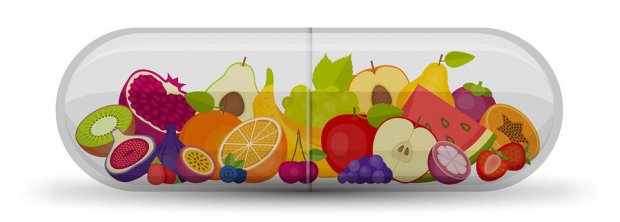








Join The Discussion - 67 comments
Ally
May 9, 2025
Hi David
Thanks for your great work in this area. I would love to take performance lab. I tried it but am super sensitive to the iron content so had to stop. Can you please recommend a supplement that hasn’t got iron in it? Thanks
David Tomen
May 9, 2025
Ally, the only thing I can recommend is the Performance Lab Men’s multi which has half the Iron compared to the women’s Multi. I cannot recommend another brand because no one else produces supplements like Performance Lab. Their NutriGenesis method is proprietary and no one else uses this method of making supplements.
Loki
February 17, 2023
Vitamin A (in the form of 10,000 IU from fish liver fat) I still do not understand what form of vitamin A is? Is it safe to take this for 120 days for example? its from Bluebonnet nutrition
David Tomen
February 19, 2023
Loki, I haven’t a clue what form it is either. Best to look or a Vitamin A supplement that says “beta-carotene” on the supplement facts label.
Dan
February 21, 2023
Vitamin A in the form of beta-carotene, in my opinion, is practically ineffective, and in addition, there are diseases in which the body is unable to convert beta-carotene to vitamin A
David Tomen
February 21, 2023
Dan you are absolutely correct and my mistake. Pre-formed Vitamin A (retinol, retinyl ester) which is found in meat, poultry, fish, and dairy products is used directly by your body.
Pro-formed Vitamin A (carotenoids, beta-carotene) must be converted in your body to retinol and retinoic acid before it can be used. Thank you for correcting my mistake. Much appreciated.